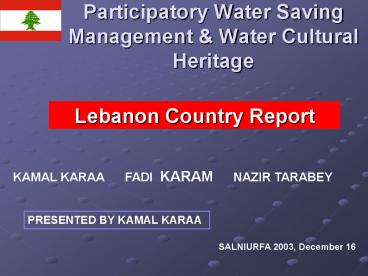Participatory Water Saving Management - PowerPoint PPT Presentation
1 / 12
Title:
Participatory Water Saving Management
Description:
KAMAL KARAA FADI KARAM NAZIR TARABEY. PRESENTED BY KAMAL KARAA. SALNIURFA 2003, December 16 ... Geographically dispersed around the national territory ... – PowerPoint PPT presentation
Number of Views:90
Avg rating:3.0/5.0
Title: Participatory Water Saving Management
1
Participatory Water Saving Management Water
Cultural Heritage
- Lebanon Country Report
KAMAL KARAA FADI KARAM NAZIR TARABEY
PRESENTED BY KAMAL KARAA
SALNIURFA 2003, December 16
2
Existing irrigation
Existing Irrigation Existing Irrigation Existing Irrigation Existing Irrigation
Total (ha) Private Small irrigation (ha) Schemed Irrigation (ha) Category
90000 24400 65600 Equipped Area
81030 21960 59070 Net irrigated area
3
(No Transcript)
4
Schemed Irrigation
- 67 schemes irrigated by surface water only 2
LRA schemes are Pressurized - 65 Schemes Gravity
System. - Geographically dispersed around the national
territory - Small to medium size and 60 (89.55) of these
schemes have an area smaller than 2000 ha and
represent 53.75 of equipped area. - Only 41.65 of irrigation schemes area is fully
irrigated in summer season - remaining area (58.35) water resources permit to
irrigate 56.5 in summer, 37.8 in winter spring
season and 5.7 stay without irrigation. - Small Farms 60 of owners have parcels fewer
than two ha size. The average farm size for all
schemes is 1.8 ha.
5
Schemed Irrigation Management
New Water Authorities Structure New Water Authorities Structure New Water Authorities Structure New Water Authorities Structure New Water Authorities Structure
Local Committees Local Committees Local Committees Previous Regional Water Authority New Water Authority
Total Irrigation Potable Previous Regional Water Authority New Water Authority
64 51 8 8 North Lebanon
70 52 11 6 Beirut Mount Lebanon
17 6 5 5 South Lebanon
58 44 14 3 Bekaa
209 153 38 22 Total
6
Consequences
- Bad Maintenance and efficiency
- Rehabilitation Since 1994
- New Organization since 2000
7
Rehabilitated Projects Results
- South Bekaa irrigation phase1 Scheme (Operating
sine 2002 ) - Saving water Consumption 9.28
- Total profit increased by 17.51 in the first
year for all the project - Benefit by ha increase by 24.17 in subscripted
area for the second year of exploitation. - Farm Size has decrease by
- 60.19 for Qaraaoun Region with modest
underground resources. - 11.80for Joub Jannine with high number of wells.
8
Rehabilitated Projects Results
- It is reflect Decreasing of rent practice mining
that direct exploitation by owners is
increasing. - Qasmieh scheme its a Gravity System scheme
operating after rehabilitation since 2000 - Water saving 33 (20 MCM)
- Water pricing policy Differential tarification
has been adopted by LRA, reducing 33.33 of fees
for farmers using pressurized equipment on farm.
As results from this policy, 503 ha are
converting to drip irrigation
9
Saving On Farm Level
- In small private irrigation, the cost paid by
farmers to extract water from wells, pushes them
to use adequate equipments making possible saving
water - In Bekaa valley all underground water users
have adopted - Sprinkler irrigation for wheat, potatoes, sugar
beets and forages. In North Bekaa, where scarcity
of water is more important (200 mm / year
compared to 800), Potato is irrigated by drip. - Drip irrigation for trees and vegetables. Black
mulch is commonly used in vegetables plantation
to reduce water losses and economizing weeds
control.
10
Role of the research - Lebanese Agricultural
Research Institute (LARI)
- Evaluation of sprinkler irrigation systems
establish suggestions for the design and work of
these systems. - Characteristics of water distribution studies
Identify the influence of principal factors of
irrigation execution, and with this information,
give suggestions to the design and management of
these systems. - Response of different herbaceous and woody crops
to differential treatments of water (deficit and
supplemental irrigations. - Developing of a management model of farms to
select the crops alternatives and the irrigation
management that get the economical optimum of the
farm, adjusted to market needs and availability
of water, agronomic factors of crops, irrigation
systems and cost of product, in addition to risks
of climatic variability and desertification.
11
Role of the research - Lebanese Agricultural
Research Institute
In early ninetys, a new line of research was
started to characterize water distribution with
medium size sprinklers and drippers to identify
the influence of principal factors that are going
to condition the execution of irrigation, and
with this information, to give suggestions to the
design and management of these systems. The
research activities were centered on the response
of different herbaceous and woody crops to
differential treatments of water (deficit and
supplemental irrigations), with analysis of their
growth and development, measuring physiological
parameters, as well as approximating the water
balance in test-plots. LARI developed a
management model of farms to select the crops
alternatives and the irrigation management that
get the economical optimum of the farm, adjusted
to market needs and availability of water,
agronomic factors of crops, irrigation systems
and cost of product, in addition to risks of
climatic variability and desertification.
12
Role of the research - Lebanese Agricultural
Research Institute
- Maximization of on-farm water use efficiency by
optimal combinations of new irrigation techniques
and water management practices - Identification and description of major farming
systems and client groups in order to define the
demand for irrigation and production
technologies - Identification of target groups of farmers and
creation of Associations of Water Users (AWU) in
the defined Irrigation Operational Units (IOU) - Adaptation and evaluation of technology at farm
level for targeted groups of farmers sharing
similar production problems - Promotion of farmer participation as
collaborators and evaluators of alternative
technologies - Promotion of collaboration with extension and
development agencies for more effective transfer
of technologies.































